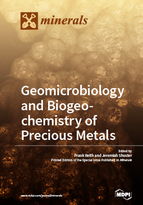Geomicrobiology and Biogeochemistry of Precious Metals
A special issue of Minerals (ISSN 2075-163X).
Deadline for manuscript submissions: closed (31 January 2018) | Viewed by 59023
Special Issue Editors
Interests: geomicrobiology; biogeochemistry; microbial ecology; OMICS; forensics; modelling; biomineralisation; gold; platinum-group-elements; uranium; synchrotron applications; bacterial metal resistance
Special Issue Information
Dear Colleagues,
Precious metals continue to have economic and sociocultural importance as their usage evolves and diversifies over time. Since antiquity, gold, silver and later platinum-group-elements have been valued as currencies and stored-investment commodities. Today, the industrial application of precious metals is increasing with developing scientific and technological innovations. For example, the discovery of microbial resistance mechanisms to highly toxic mobile precious metals can be used in biosensors and bioindicators for gold, silver and platinum, thereby expanding biotechnology into mineral exploration and hydrometallurgy. From a geochemical perspective, the in situ cycling and transformation of precious metals is a dynamic balance between dissolution-, transport- and re-precitation processes that are catalysed by the biosphere. Microbial weathering mobilises precious metals by releasing metals ‘trapped’ within minerals and by solubilising these metals via oxidation-promoting complexation. Higher organisms such as plants mitigate precious metal mobility within soils as well as within hydrological regimes. The cycling of precious metals is completed as microbes destabilise soluble metal complexes through bioprecipitation and biomineralisation forming secondary colloids, crystalline microparticles, as well as macroscopic grains and even nuggets.
This Special Issue aims to bring together studies in the areas of geomicrobiology and biogeochemistry of precious metals. Contributions that demonstrate or enhance the fundamental understanding of how biogenic process affect precious metal cycling of or how organisms are effected by mobile precious metals are invited. We especially encourage studies highlighting biological applications for precious metal exploration, mineral/ore processing and bioremediation to encourage sustainable use of resources.
Dr. Frank Reith
Dr. Jeremiah Shuster
Guest Editors
Manuscript Submission Information
Manuscripts should be submitted online at www.mdpi.com by registering and logging in to this website. Once you are registered, click here to go to the submission form. Manuscripts can be submitted until the deadline. All submissions that pass pre-check are peer-reviewed. Accepted papers will be published continuously in the journal (as soon as accepted) and will be listed together on the special issue website. Research articles, review articles as well as short communications are invited. For planned papers, a title and short abstract (about 100 words) can be sent to the Editorial Office for announcement on this website.
Submitted manuscripts should not have been published previously, nor be under consideration for publication elsewhere (except conference proceedings papers). All manuscripts are thoroughly refereed through a single-blind peer-review process. A guide for authors and other relevant information for submission of manuscripts is available on the Instructions for Authors page. Minerals is an international peer-reviewed open access monthly journal published by MDPI.
Please visit the Instructions for Authors page before submitting a manuscript. The Article Processing Charge (APC) for publication in this open access journal is 2400 CHF (Swiss Francs). Submitted papers should be well formatted and use good English. Authors may use MDPI's English editing service prior to publication or during author revisions.
Keywords
- Geomicrobiology
- Biogeochemistry
- Precious metals
- Gold, silver, platinum-group-elements
- Prokaryotes
- Fungi
- Plants
- Biomineralisation
- Metal-resistance
- Exploration
- Metallurgy
- Bioremediation






